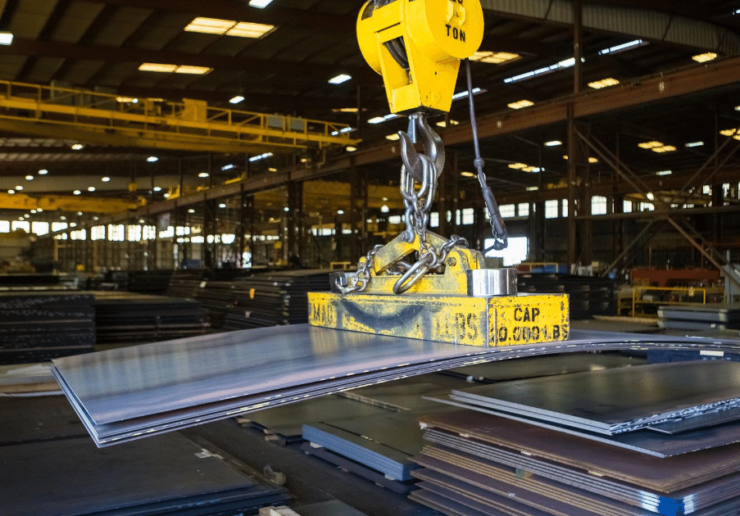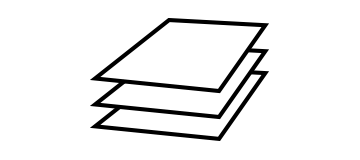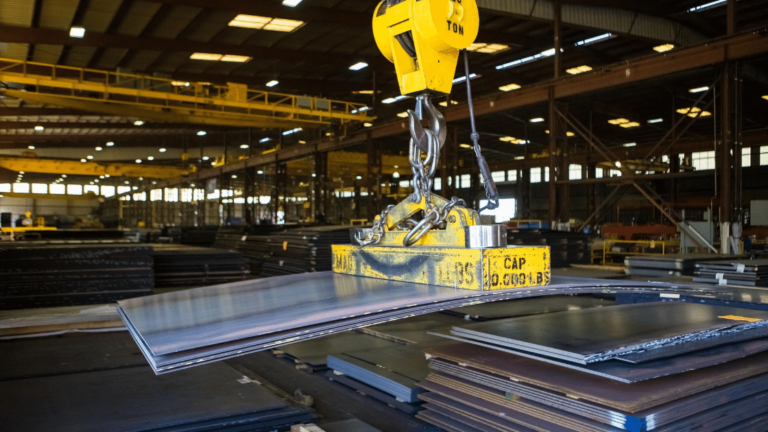Kloeckner Metals is proud to routinely stock a range of carbon steel plate grades across our 40+ branches. Reach out to us to see how we can meet your needs.


| Grades | Thickness | |||
|---|---|---|---|---|
| Width | Length | |||
| A36 | 3/16" - 8" | 48" - 120" | 96" - 480" | |
| A572 Grade 42 | 50 | 60 | 65 | 3/16" - 6" | 48" - 120" | 96" - 480" | |
| A588 | 3/16" - 4" | 48" - 120" | 96" - 480" | |
| A871-65 | 3/16" - 1-1/4" | 48" - 120" | 96" - 650" | |
| A709 Grade 36 | 50 | 50W | 3/16" - 4" | 48" - 120" | 96" - 480" | |
| A656 Grade 50 | 60 | 70 | 80 | 3/16" - 1" | 48" - 120" | 96" - 480" | |
| 1045 | Inquire for sizes | |||
| 33 MAX | Inquire for sizes | |||
A36 carbon steel plate is a common structural steel that has a minimum yield strength of 36,000. You’ll find A36 in a range of applications and industries because it adds rigidity and strength to projects at a better value than other steel plate grades. Available throughout Kloeckner Metals in a variety of thicknesses, widths, and lengths, A36 can be welded, bolted, and riveted. Because of its versatility and popularity, Kloeckner Metals keeps it stocked throughout its 40+ North American locations.
Already a customer? Shop A36 on Kloeckner Direct.
Kloeckner Metals routinely stocks A572 carbon steel plate in four grades: 42, 50, 60, and 65. A572 is a popular steel plate grade that is found in bridges, construction equipment, buildings, machinery, transmission towers, truck parks, freight cars, and more. A high-strength, low-alloy HSLA steel plate, A572 offers a trifecta of strength, weldability, and notch toughness.
Already a customer? Shop A572 on Kloeckner Direct.
A588 is a high-strength, low-alloy HSLA steel plate that’s commonly found in structural applications like buildings and bridges. It has superior weathering ability to A572 and, because of its increased corrosion resistance, is more common in projects subject to harsher outdoor conditions. Even unpainted, A588 is four times more corrosion resistant than carbon steel. Highly weldable, A588 stays strong for the entire lifetime of structures. Kloeckner Metals routinely stocks A588 across its 40+ locations.
Already a customer? Shop A588 on Kloeckner Direct.
A871 is a structural steel plate that’s ideal for tubular structures like poles. With superior corrosion resistance, even unpainted, this carbon steel plate grade is commonly used in outdoor settings exposed to the elements. Kloeckner Metals routinely stocks A871 in grade 65.
Already a customer? Shop A871-65 on Kloeckner Direct.
A709 is a common steel plate that is available in both standard and high-performance grades. Kloeckner Metals offers grades 36, 50, and 50W, as well as heavy steel plate that can have thicknesses of 3 inches or more. The A709 steel plate is used in different applications, including the manufacturing of bridges. This steel is weldable by all conventional methods. When A709 steel is properly designed, it can be used for many applications in the unpainted condition.
A656 steel is a high-strength, low alloy HSLA steel plate. Kloeckner offers A5656 in four different grades: 50, 60, 70, and 80. This specific steel has good formability, weldability, and toughness. The A656 does well in low and ambient temperatures and, due to its strength, is typically used in the construction industry. Some common applications include truck frames, construction equipment, crane booms, and general fabrication.
Already a customer? Shop A656 on Kloeckner Direct.
1045 high carbon steel plate is stocked throughout Kloeckner’s North American facilities. 1045, otherwise known as A830, has high strength and hardness, it can be heat-treated as needed, and it can generate a wide range of beneficial properties. This makes high carbon 1045 a regular candidate for steel plate. Some common applications include the manufacturing of axles, shafts, gears, bolster plates, base plates, as well as other machine parts.
Already a customer? Shop A830-1045 on Kloeckner Direct.
33 Max steel is steel comprised of up to .33 carbon. It is used in applications that don’t require specific physical or mechanical properties. Kloeckner Metals supplies it in an as-rolled condition throughout our North American facilities.
Already a customer? Shop 33 Max on Kloeckner Direct.
A36 carbon steel plate is a common structural steel that has a minimum yield strength of 36,000. You’ll find A36 in a range of applications and industries because it adds rigidity and strength to projects at a better value than other steel plate grades. Available throughout Kloeckner Metals in a variety of thicknesses, widths, and lengths, A36 can be welded, bolted, and riveted. Because of its versatility and popularity, Kloeckner Metals keeps it stocked throughout its 40+ North American locations.
Already a customer? Shop A36 on Kloeckner Direct.
Kloeckner Metals routinely stocks A572 carbon steel plate in four grades: 42, 50, 60, and 65. A572 is a popular steel plate grade that is found in bridges, construction equipment, buildings, machinery, transmission towers, truck parks, freight cars, and more. A high-strength, low-alloy HSLA steel plate, A572 offers a trifecta of strength, weldability, and notch toughness.
Already a customer? Shop A572 on Kloeckner Direct.
A588 is a high-strength, low-alloy HSLA steel plate that’s commonly found in structural applications like buildings and bridges. It has superior weathering ability to A572 and, because of its increased corrosion resistance, is more common in projects subject to harsher outdoor conditions. Even unpainted, A588 is four times more corrosion resistant than carbon steel. Highly weldable, A588 stays strong for the entire lifetime of structures. Kloeckner Metals routinely stocks A588 across its 40+ locations.
Already a customer? Shop A588 on Kloeckner Direct.
A871 is a structural steel plate that’s ideal for tubular structures like poles. With superior corrosion resistance, even unpainted, this carbon steel plate grade is commonly used in outdoor settings exposed to the elements. Kloeckner Metals routinely stocks A871 in grade 65.
Already a customer? Shop A871-65 on Kloeckner Direct.
A709 is a common steel plate that is available in both standard and high-performance grades. Kloeckner Metals offers grades 36, 50, and 50W, as well as heavy steel plate that can have thicknesses of 3 inches or more. The A709 steel plate is used in different applications, including the manufacturing of bridges. This steel is weldable by all conventional methods. When A709 steel is properly designed, it can be used for many applications in the unpainted condition.
A656 steel is a high-strength, low alloy HSLA steel plate. Kloeckner offers A5656 in four different grades: 50, 60, 70, and 80. This specific steel has good formability, weldability, and toughness. The A656 does well in low and ambient temperatures and, due to its strength, is typically used in the construction industry. Some common applications include truck frames, construction equipment, crane booms, and general fabrication.
Already a customer? Shop A656 on Kloeckner Direct.
1045 high carbon steel plate is stocked throughout Kloeckner’s North American facilities. 1045, otherwise known as A830, has high strength and hardness, it can be heat-treated as needed, and it can generate a wide range of beneficial properties. This makes high carbon 1045 a regular candidate for steel plate. Some common applications include the manufacturing of axles, shafts, gears, bolster plates, base plates, as well as other machine parts.
Already a customer? Shop A830-1045 on Kloeckner Direct.
33 Max steel is steel comprised of up to .33 carbon. It is used in applications that don’t require specific physical or mechanical properties. Kloeckner Metals supplies it in an as-rolled condition throughout our North American facilities.
Already a customer? Shop 33 Max on Kloeckner Direct.

Carbon steel generally refers to steel that is not stainless steel, which is itself defined by the presence of at least 11% chromium. In comparison, carbon steel has no minimum specification for an alloying element, whether it is chromium, aluminum, cobalt, nickel, or others. What is usually true of carbon steel’s chemical composition is that the manganese won’t exceed 1.65%, the copper hovers between 0.4% and 0.6%, and the silicon won’t exceed 0.6%. Kloeckner supplies low, medium, and high carbon plate in a range of grades and thicknesses across North America.
ANSWER:
There are many grades of steel that cover a range of physical, chemical, and environmental properties. While all steel is made up of iron and steel, the grade of steel is determined by the amount of content and the addition of alloys.
According to ASTM International, each metal receives a letter prefix based on its category. Iron and steel materials like carbon steel plate have been assigned the prefix, “A”. After the letter prefix comes a number that corresponds with specific properties.
While the number is sequentially assigned, there are several types of carbon steel that cross multiple market segments, and there is no consistent logic to the number. While the “36” in A36, for example, refers to a minimum yield strength of 36,000, the same logic doesn’t apply to A709, for example.
ANSWER:
While carbon steel is strong and durable, it lacks the corrosion resistance of stainless steel. If exposed to moisture, it may rust or corrode.
ANSWER:
There are three types of carbon steel: low, medium, and high carbon steel. Generally, the higher the carbon content, the stronger and more durable the plate is, but also less ductile and weldable.
Low carbon steel is sometimes known as “mild steel” and contains between 0.04% and 0.30% carbon. Low carbon steel is one of the largest subsets of carbon steel, covering a large number of shapes from flat sheet to structural beam. End-uses depend on the composition and resulting properties. For example, structural steel utilizes higher carbon and manganese content.
Medium carbon steel ranges in carbon content from 0.31% to 0.60% and manganese content from 0.060% to 1.65%. While it is stronger than low carbon steel, it is more difficult to weld, form, and cut. You’ll frequently see medium carbon steels hardened and tempered with heat treatment.
High carbon steel is also called “carbon tool steel” and ranges in carbon content from 0.61% to 1.50%. With the higher carbon, it becomes even more difficult to weld, form, and cut, and becomes hard and brittle when heat treated.
ANSWER:
Please see our metal weight calculator. In general, calculating the weight of carbon steel plate is a simple calculation that takes the thickness, width, and length into account to return a weight per piece and total weight.
ANSWER:
Kloeckner Metals is proud to be a top steel plate supplier that can source and deliver it nationwide. Contact us using the form above.
ANSWER:
When it comes to carbon steel plates, you’ll typically see the following grades:
While Kloeckner does not routinely stock all of the most common carbon steel plates, we invite you to request a quote above to see how we can service your needs.
ANSWER:
There are many grades of steel that cover a range of physical, chemical, and environmental properties. While all steel is made up of iron and steel, the grade of steel is determined by the amount of content and the addition of alloys.
According to ASTM International, each metal receives a letter prefix based on its category. Iron and steel materials like carbon steel plate have been assigned the prefix, “A”. After the letter prefix comes a number that corresponds with specific properties.
While the number is sequentially assigned, there are several types of carbon steel that cross multiple market segments, and there is no consistent logic to the number. While the “36” in A36, for example, refers to a minimum yield strength of 36,000, the same logic doesn’t apply to A709, for example.
ANSWER:
While carbon steel is strong and durable, it lacks the corrosion resistance of stainless steel. If exposed to moisture, it may rust or corrode.
ANSWER:
There are three types of carbon steel: low, medium, and high carbon steel. Generally, the higher the carbon content, the stronger and more durable the plate is, but also less ductile and weldable.
Low carbon steel is sometimes known as “mild steel” and contains between 0.04% and 0.30% carbon. Low carbon steel is one of the largest subsets of carbon steel, covering a large number of shapes from flat sheet to structural beam. End-uses depend on the composition and resulting properties. For example, structural steel utilizes higher carbon and manganese content.
Medium carbon steel ranges in carbon content from 0.31% to 0.60% and manganese content from 0.060% to 1.65%. While it is stronger than low carbon steel, it is more difficult to weld, form, and cut. You’ll frequently see medium carbon steels hardened and tempered with heat treatment.
High carbon steel is also called “carbon tool steel” and ranges in carbon content from 0.61% to 1.50%. With the higher carbon, it becomes even more difficult to weld, form, and cut, and becomes hard and brittle when heat treated.
ANSWER:
Please see our metal weight calculator. In general, calculating the weight of carbon steel plate is a simple calculation that takes the thickness, width, and length into account to return a weight per piece and total weight.
ANSWER:
Kloeckner Metals is proud to be a top steel plate supplier that can source and deliver it nationwide. Contact us using the form above.
ANSWER:
When it comes to carbon steel plates, you’ll typically see the following grades:
While Kloeckner does not routinely stock all of the most common carbon steel plates, we invite you to request a quote above to see how we can service your needs.
Between our global footprint, international transportation network,...

X
The Kloeckner Metals website uses modern technologies. Unfortunately, your browser doesn't support those technologies.
Download the latest version of one of these browsers to experience the site: